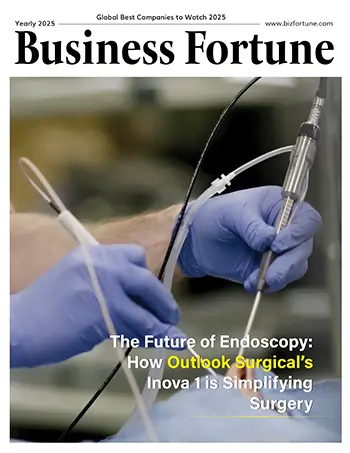Home Industry Space Space Tourism: How Close Are W...
Space Tourism: How Close Are We to Commercial Space Travel?
Space

Business Fortune
04 October, 2024
Although the concept of space tourism sounds like something from a sci-fi movie set in the future of space exploration, it has really been operating for nearly two decades. As some may remember, in 2001 American businessman Dennis Tito became the first non-military visitor to the International Space Station. At twenty million dollars, Tito's space voyage was an extravagant endeavor; for most of us, space travel would remain a pipe dream reserved for movies and novels.
The idea of space travel fills us with amazement and interest while arousing our curiosity. For good reason, this growing business has accelerated in the last several years. The prospect of venturing outside Earth's atmosphere and into the infinite reaches of space has enthralled people for countless millennia. This dream is no longer exclusive to scientists and astronauts thanks to recent Space tourism technology advancements, and the idea of achieving it is alluring enough to anybody.
Space Tourism: What Is the Space Tourism Industry's Potential Market?
According to recent projections, the commercial space travel business has exceptional economic potential, and over the next 10 years, substantial expansion is anticipated. According to a UBS research, space tourism costs might have a $4 billion yearly business by 2030. According to a different Morgan Stanley analysis, the worldwide aerospace tourism technology market may bring in $1 trillion or greater in revenue by 2040.
Investing in publicly listed corporations or supporting startups as well as pre-IPO enterprises with significant development potential are two ways that investors might fund commercial space travel. Investing might entail buying shares in well-known aerospace firms that are branching out into space tourism or in startups that are only focused on this sector.
The Rise of Space Tourism: A New Frontier
The first days of space exploration are when the concept of space tourism originated. NASA studied launching private individuals into space in the 1980s, but the devastating Challenger accident in 1986 forced the agency to shelve such plans. Space tourism industry growth didn't actually take off until 2001, when American billionaire Dennis Tito paid $20 million to go on a Russian Soyuz spacecraft to the International Space Station (ISS). Tito's voyage ushered in a new era by demonstrating that amateur astronauts could undertake space missions.
How Close Are We to Commercial Space Travel?
We're getting closer to the fascinating frontier of commercial space Travel. To make space tourism industry growth a reality, businesses like SpaceX, Virgin Galactic, and Blue Origin space tourism are making significant investments in Space tourism technology. Although Virgin Galactic flights have begun providing places for suborbital space flights, its services are now only offered to a select group of high-paying clients. By 2025, SpaceX space mission hopes to have tourists orbiting the moon, and it has more manned flights to Mars planned. Although a precise timeframe is difficult to determine, industry insiders believe that regular and inexpensive commercial space travel will be possible over the next 10 to 20 years.
Challenges Facing the Space Tourism industry growth
-
Environmental Impact:
-
Rocket and spacecraft launches can result in considerable air and noise pollution and demand a lot of energy.
-
The atmosphere may be harmed by these emissions, which also contribute to climate change.
-
-
Safety Issues:
-
Safety precautions notwithstanding, there is always a chance of an accident with potentially disastrous results.
-
-
Cost:
-
Commercial space travel is now a costly endeavor available exclusively to the rich. As a result, numerous individuals won't have the opportunity to experience space flight, which might engender emotions of unfairness and elitism.
-
According to a recent NASA report, SpaceX space mission – Space Adventures intended to charge between USD 70 and USD 100 million (about Rs 600 and 850 crore) for a lunar orbital trip.
-
-
Space Debris:
-
Debris from spacecraft launches may remain in space for a long time, and as more space launches occur, there is a corresponding increase in debris.
-
Even little debris can result in damage and pose issues for other spacecraft.
-
-
Depletion of Resources:
-
A significant quantity of energy, fuel, & materials are needed for space flight.
-
The ecosystem and the accessibility of goods for future of space exploration, generations may suffer from a shortage of these resources, which might have long-term effects.
-
-
Legal Concerns:
-
Since the legal structure for space tourism remains in its infancy, it is unclear who will be responsible for any problems that may occur.
-
The Convention on Principles Governing the Engagements of States in the Exploration and Utilization of Outer Space, particularly the Moon and Other Celestial Bodies, as well as the effects of space tourism technology on global space laws are issues as well.
-
Another name for it is the Outer Space Treaty. Signed in 1967, this multilateral pact serves as the cornerstone of international space law.
-
-
The Future of Space Tourism: What’s next?
Although it may appear that only the very wealthy can finance space travel, there are other factors at play as well. Anyone has the chance to take part in something genuinely extraordinary, breathtaking, and transformative. There is no denying the allure of space tourism—the opportunities to experience weightlessness, see the planet's beauty from afar, and view the globe from a whole new angle.
Recent years have seen a tremendous space tourism industry growth, which has the potential to rank among the most valuable in the world. The need for space travel is increasing, even if the sector remains in its infancy. From 2023 to 2030, it is predicted to rise at an annual rate of 40.2%. The market for space tourism cost was estimated to be USD 695.1 million globally in 2022 and is expected to grow to USD 8,669.2 million by 2030.
Despite being relatively new, the space tourism sector already includes a number of significant players:
-
Blue Origin
-
Orion Span
-
Boeing
-
Zero-G
-
Space Adventure
-
Zero 2 Infinity
-
World View
-
Space Perspective
-
Nanoracks
-
Axiom
Conclusion:
Due to substantial technical developments and rising commercial demand, space tourism is poised to become a real thing rather than just a pipe dream. The sector has enormous potential, despite obstacles including high costs, space travel safety issues, and environmental effect. The temptation of seeing the universe with your own eyes grows stronger as we approach a day when more people than just the rich elite may be able to afford space flight. The space tourism business is expected to develop rapidly in the next years, making it one of the most fascinating frontiers of the contemporary era. As we go forward, many people's dreams of visiting the last frontier could soon come true, changing the way we think about travel, adventure, and our role in the cosmos.
FAQ:
-
What is space tourism?
Commercial space travel for pleasure, adventure, or leisure is referred to as space tourism.
-
How much does space tourism cost?
Presently space tourism costs around $250,000, while moon visits cost between $70-100 million.
-
How safe is space tourism?
The inherent hazards of space flight mean that even with space travel safety Precautions in place, risks still exist.
-
When will space tourism be widely available to the public?
Within the next ten to twenty years, frequent, reasonably priced space travel may become possible, according to experts.
-
What are the environmental impacts of space tourism?
Space tourism has the potential to worsen resource depletion, pollution from noise and air, climate change, and space debris.


































